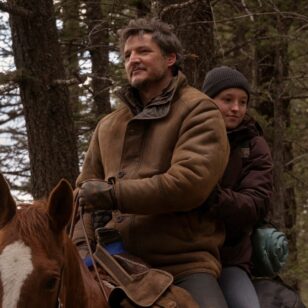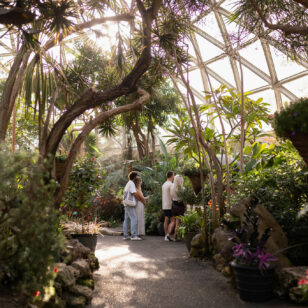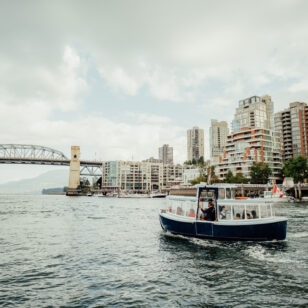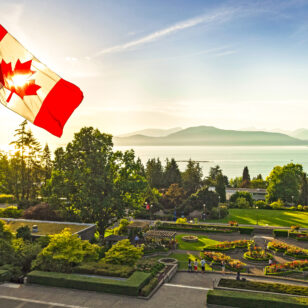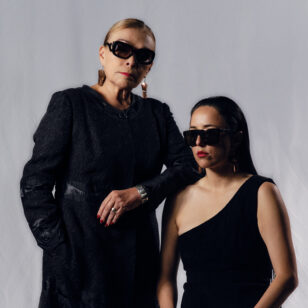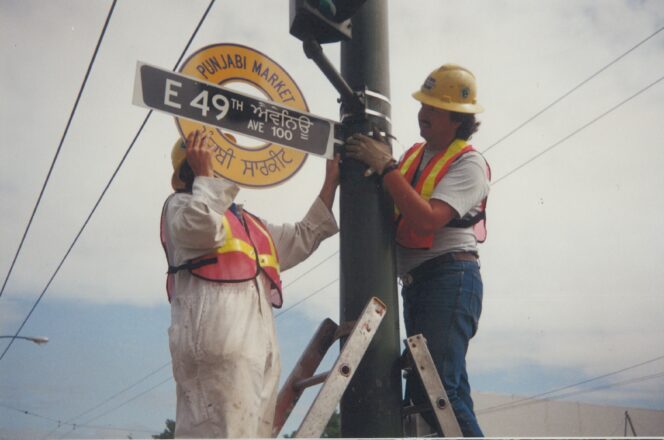
In 1993, the Punjabi Market featured the first Punjabi street signs beyond Asia. Photo Source: Pabla Family
Gulzar Nanda has a deep and enduring love for the Punjabi Market. The area, located on Main Street, from roughly East 48th to East 51st Avenue, represents the historical heart of Vancouver’s South Asian community. Nanda’s parents immigrated to Canada from India, and opened Hi-Class Jewellers in the neighbourhood in 1989. During his lunchtime break from school, Nanda would run down with his friends to the Punjabi Market, buying chips and candy from Punjab Food Centre, owned by Harinder Toor. Because many of his friends also had parents who owned businesses in the area, they quickly established camaraderie. “The Punjabi Market was like a playground for us. We’d come after school to our parents’ shops, and we’d hang out together while our parents worked,” he says.
Nanda, now co-manager of his family’s jewelry shop, is on a mission to rejuvenate this important neighbourhood through his work as chair of the Punjabi Market Regeneration Collective (PMRC).
Nanda explains that although the Punjabi Market Regeneration Collective officially launched as a non-profit last year, it came together organically during meetings when concerned residents discussed the future of the neighbourhood. “The PMRC was created because there wasn’t a mechanism by which the community could be involved in the Punjabi Market,” Nanda says. The Collective encompasses a wide range of individuals, from students to advocate workers from across the Lower Mainland, all united in this inspiring cause. As Nanda explains, the PMRC’s mandate is simple, yet powerful: “To preserve the Punjabi Market for our elders and our youth.”
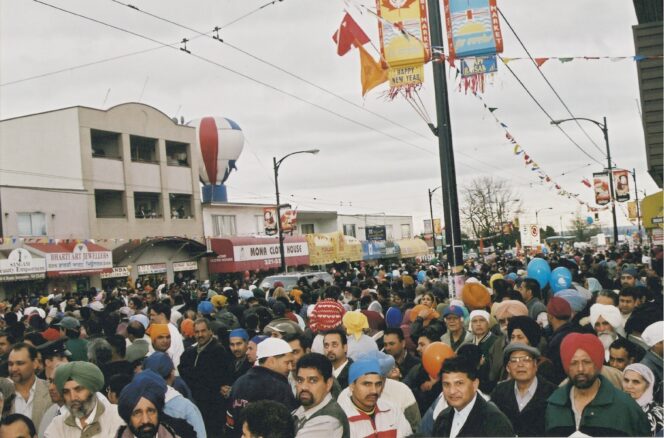
Photo Source: Pabla Family
The Punjabi Market has a long and proud history as the oldest and largest “Little Punjab” in North America. Its story began on May 31, 1970, when Sucha Singh Claire opened Shaan Saari’s with a vision of initiating a vibrant South Asian neighbourhood in Vancouver similar to what existed in Southhall, London. The area flourished in the 1980s, but then saw decline in the late 2000s as the global financial crisis exacted its toll and families and businesses started relocating elsewhere.
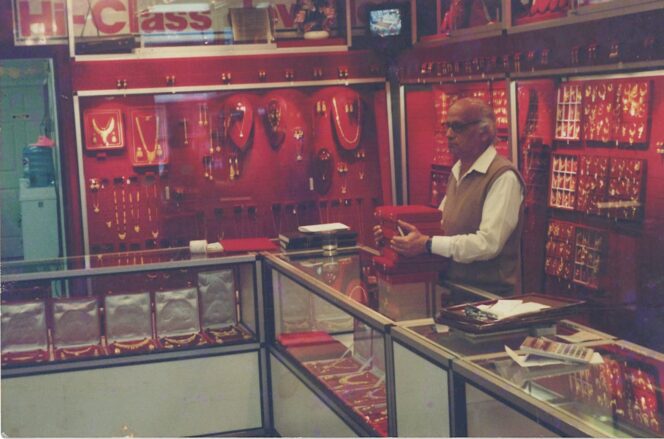
Hi-Class Jewellers; Photo Source: Nanda Family
But especially in the last couple of years, the neighbourhood has taken on a new optimism, in part due to the efforts of the PMRC and its many passionate members. “This is a community-led group who is thinking of the future. I feel like now there is hope in the community, says Nanda.

Jay Nagra with Gulzar Nanda
The PMRC is giving the area a second life through initiatives focused on public art and cultural celebration. “Public art is really important in shaping the identity of a space,” says Nanda. In April, as part of a collaboration with Indian Summer Festival (ISF), they launched a street banner campaign spotlighting the work of Musqueam (Xʷməθkʷəy̓əm) artist, Debra Sparrow (θəliχʷəlʷət), and ISF 2021’s Featured Artist and PMRC Creative Director, Jag Nagra. The banners, with their exuberant colours, give the streets of the Punjabi Market a cheerful energy.
Nagra also was the driving creative force behind Marigolds in the Market, a public art installation centred on marigold garlands, which often appear at South Asian festivities, like weddings. The orange and red garlands hang from the branches of a tree at Main and East 51st Avenue, swaying in the wind for all to happily admire.
Most recently, the PMRC joined forces with Vancouver Mural Festival (VMF) to commission 4 murals after realizing there were only 6 pieces of public art in the whole of the Sunset area. Guest curator, Jas Lally, brought together a group of emerging BIPOC artists (Guntaj Deep Singh, Sandeep Johal, Minahil Bukhari and Mustaali Raj, and Diamond Point) that PMRC wanted to support and spotlight during difficult economic times. Singh’s mural, “The Golden Land” depicts a harvest in rural Punjab, capturing a nostalgic image of hard work, family and tradition. Meanwhile, “Shahi Tukra” by Bukhari and Raj takes its inspiration from North Indian royal palaces to pay homage to the initial immigrants who made the area their home.
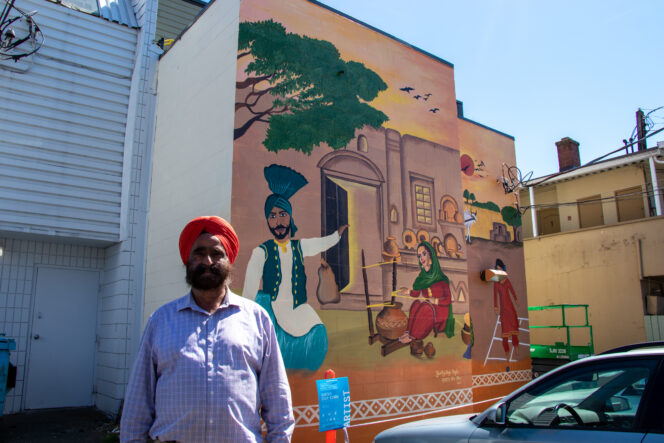
Guntaj Deep Singh’s “The Golden Land”; Photo Credit: Jamie Sekhon
Nanda voice is suffused with pride when he talks about the value of visiting the Punjabi Market. “If you come to the Punjabi Market, you’re really stepping into a place where a South Asian entrepreneur can take ownership over their own financial future and be able to provide for their family,” he says. Many of the businesses that opened in the Punjabi Market’s early days still stand today, like Sadhna Saree House and Himalaya Restaurant, which both opened in the 1970s.
Nanda invites you to stop by the Market, where you can shop for a range of items, like jewelry, houseware, and gorgeous fabric, as well as dine at restaurants, like All India Sweets & Restaurant and Tandoori Oven, for a delicious meal. And while you’re there, you can take in the public art that is making the neighbourhood once again a destination for those interested in South Asian history and culture.
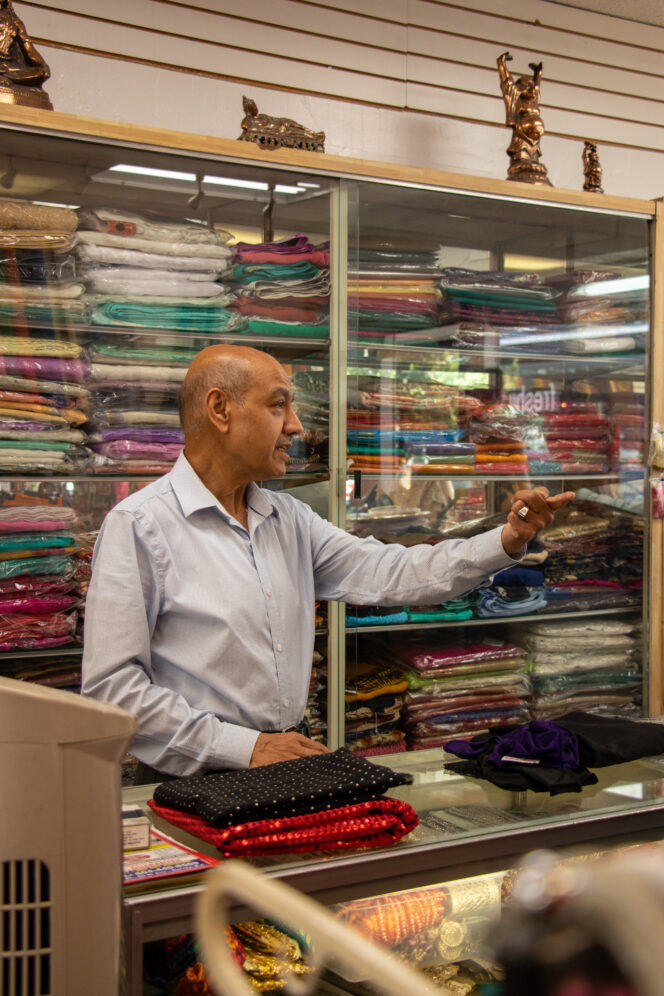
Photo Credit: Jamie Sekhon
People are constantly coming into Nanda’s shop and telling him that they’re finally returning to the Market after years of not frequenting it. “It’s the energy around the idea of this place. People are attracted to that. It’s not one single thing. It’s the entire constellation of the work that we’ve achieved. There is a renewed sense of ownership and pride for the Punjabi Market,” he says.
In the works are spruced up planters, more murals for next year’s VMF, and lively outdoor events that will foster further connection. And although the PMRC is still working out the specifics of their next projects, one thing is for sure: the future for the Punjabi Market is incredibly bright.











